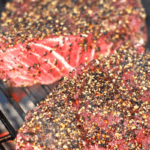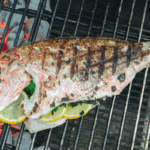Grilling fish can be one of the most terrifying things to do. It’s notoriously difficult to handle over a hot fire, easily sticking to the grates, flaking apart, or overcooking. Similarly, a perfectly grilled piece of seafood can be a thing of beauty, light and fresh with a pleasing simplicity. With a few pointers, every backyard griller can get it right.
How to Choose the Fish
There is no right or wrong answer here. We also have compiled a guide that will help you choose the best fish for grilling.
The grill can handle everything from delicate fillets to giant steaks, and even whole fish. Although, going through every type and cut of fish would probably be an exercise in patience; so, for this post, let’s stick to fish that’s easily thrown over the flames, using no tools or procedures other than oil, salt, and pepper.
Choosing a fish for grilling begins with considering its heartiness – how well it can withstand the fire. Flaky or delicate fish, such as flounder or sole, won’t cut it here. Thicker fillets or steaks of stronger contenders, such as:
- Halibut
- Tuna
- Swordfish
- Haddock
- Salmon
- Mahi-mahi
- Grouper
They will be able to withstand the fire and the ever-tricky process of flipping. With a thick slab of seafood, you really don’t need to do much in terms of food preparation other than coat it liberally in oil, salt, and pepper. Grilling is the key to making that fish great.
Keeping the Grill Clean Will Keep the Fish Happy
What can you do to keep the fish from sticking? Although I’ve grilled a lot of fish at this point, I still get hung up with a sticker from time to time. The most frustrating part is that you can never blame it on the seafood. It usually comes down to not properly prepping the grill, which is crucial to success.
The grill needs to be cleaned first. It is best to cover the grill right when the coals are all lit and the fire is at its hottest. With a good grill brush, you can then easily brush away any remnants of nastiness on the grill grate after five minutes of this heat.
The grates should also be oiled afterward, which is best accomplished with a cloth or paper towel dipped in vegetable or olive oil and then whipped over the grates.
When you’re grilling you can make mistakes if you don’t do these two things. As soon as both are done, the fish can be thrown over the medium-hot fire.
Flip It
Now that the fish has been cooking for a bit, you can see the bottom becoming opaque, indicating that it could be time to flip it. With a clean and oiled grate and an oiled fish, you should be able to prevent total stickage. However, there are two other factors to consider if you want a successful flip.
You need the right tool first. The best tool for the job is a wide spatula with a thin, tapered edge. The net can slide easily under the fish, and it’s also large enough to hold the whole fillet while you flip it. Combine it with a flexible turner, which can help hold the fish in place while the larger spatula is slid underneath.
You should stop if you encounter any resistance while attempting the turn. The fish will release itself from the grate when it is ready to turn when you have cleaned and oiled the grate properly. The spatula will help undo some light sticking, but if you feel like you are hurting the fish more than helping it, it may be that it just needs a minute or two to finish the turn.
Almost Done
Once the fish is flipped, you should feel a great sense of accomplishment. Don’t bask in the glory too long, as it will all be for naught if the fish gets overcooked and starts to dry out.
I take the visual route with fish, as opposed to cooking other meats, for which I rely entirely on an instant-read thermometer. The goal is to pull the fish just before it is fully cooked (unless you are purposefully undercooking, such as for tuna or salmon) – and let it continue cooking as it rests off the grill — and it is not hard to tell when it has reached that point.
As the fish cooks through, it begins to flake and becomes opaque. To determine whether it is done, pull back a flaky section in the center with a fork. When a fish is opaque with a bit of translucent center, it’s ready to pop off.
There is still the thermometer route, which is admittedly more failsafe (and maybe I should change my ways). A fish should be pulled when it registers between 130 and 135°F (54 and 57°C) on an instant-read thermometer; it will continue to heat up to about 140°F (60°C) as it rests.
To preserve your skillful work, use the same delicate care to remove the fish from the grill with the spatulas.
You Are the Fish-Grilling Master Now
Give yourself a pat on the back, and enjoy the results of your fish-grilling skills. Served as-is, fresh fish with a nice sear and a faint smokiness is a proud thing to serve. A squirt of lemon juice livens it up a bit, but for seafood fans, that’s about it.
If you’re like me, and don’t like seafood in its natural state, we’ve got some great options for topping those beautiful fillets. Pesto adds a nice Italian flair. A grilled-pineapple salsa will add a fruity touch. You might also like romesco sauce, chimichurri, gremolata, cilantro pesto, or black olive tapenade.
Fresh fish on the grill is delicious, no matter how you serve it. We hope this guide has dispelled all of your fears of fish, and you’re on your way to becoming a master seafood griller.
Was this helpful?
Hi there! I’m a food enthusiast and journalist, and I have a real passion for food that goes beyond the kitchen. I love my dream job and I’m lucky enough to be able to share my knowledge with readers of several large media outlets. My specialty is writing engaging food-related content, and I take pride in being able to connect with my audience. I’m known for my creativity in the kitchen, and I’m confident that I can be the perfect guide for anyone looking to take their culinary journey to the next level.







